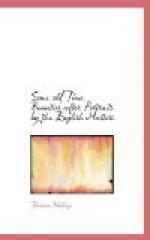One day the housekeeper of Hampton Court was showing the palace to visitors when the sisters were there. She threw open the door where they were sitting, saying, “This is our beauty-room.” The pictures and galleries were forgotten by the crowd, which gazed on the beauties instead.
For a decade their beauty was regnant in London. They were not politicians as were their Graces of Gordon and Devonshire, nor had they the ability to become such. Neither were they the associates of brilliant, intellectual men, but participants in the gay, vacuous, showy society of the rapid set of the aristocracy. The elder sister gained the coronet of Coventry, but her vanity caused her own undoing; the younger was a part of the exhibition of “Beauty and the Beast.” A high price was paid for her position by the endurance of a period of tyranny and terror.
Some praise must be accorded the beauties, for at a time of much licentiousness of a profligate society and tolerated coarsenesses, the sisters determinedly kept their names free from ignoble soil and scandal.
[Illustration: MARIA COUNTESS OF COVENTRY by HAMILTON]
MARIA GUNNING
“Two Irish girls of no fortune, who make more noise than any of their predecessors since the days of Helen, and who are declared the handsomest women alive.” So wrote Walpole, in June, 1751. If we were to judge of their beauty by the pictured presentments of it, we would certainly agree with “our Horace” when he says he has seen much handsomer women than either. We have no adequate image of their surpassing loveliness, the beholding of which would cause us to feel how merited was their meed of praise, how fair the contemporary comment on their comeliness, and how just the wide fame of a beauty which tradition has epitomized for us in the phrase, “The Fair Gunnings.” Though the print publishers of the time actively issued portraits, we feel that none of them picture such a person as would set society and the whole city of London astir by her blazing beauty.
The best-known likenesses are the various pictures by Francis Cotes, one of the founders of the Royal Academy, a painter of considerable merit, who was born about 1725, and died in 1770. It is said that Hogarth preferred him as a portrait painter to Reynolds. His studio was in Cavendish Square, and at his death was taken by Romney; and it was while he worked there that Sir Joshua referred to his rival as “the man in Cavendish Square.” The studio was later occupied by Sir Martin Shee.
Cotes’s picture of Maria is a half length of a modestly dignified lady, having no tendency at all to that silliness that Walpole insinuates was characteristic of her. The face is oval, the eyebrows well apart and distinctly arched, and the hair brushed back from the forehead and falling on the very graceful neck. The dress is cut low, showing a delicately-moulded bosom. This picture was mezzo-tinted by McArdell;




